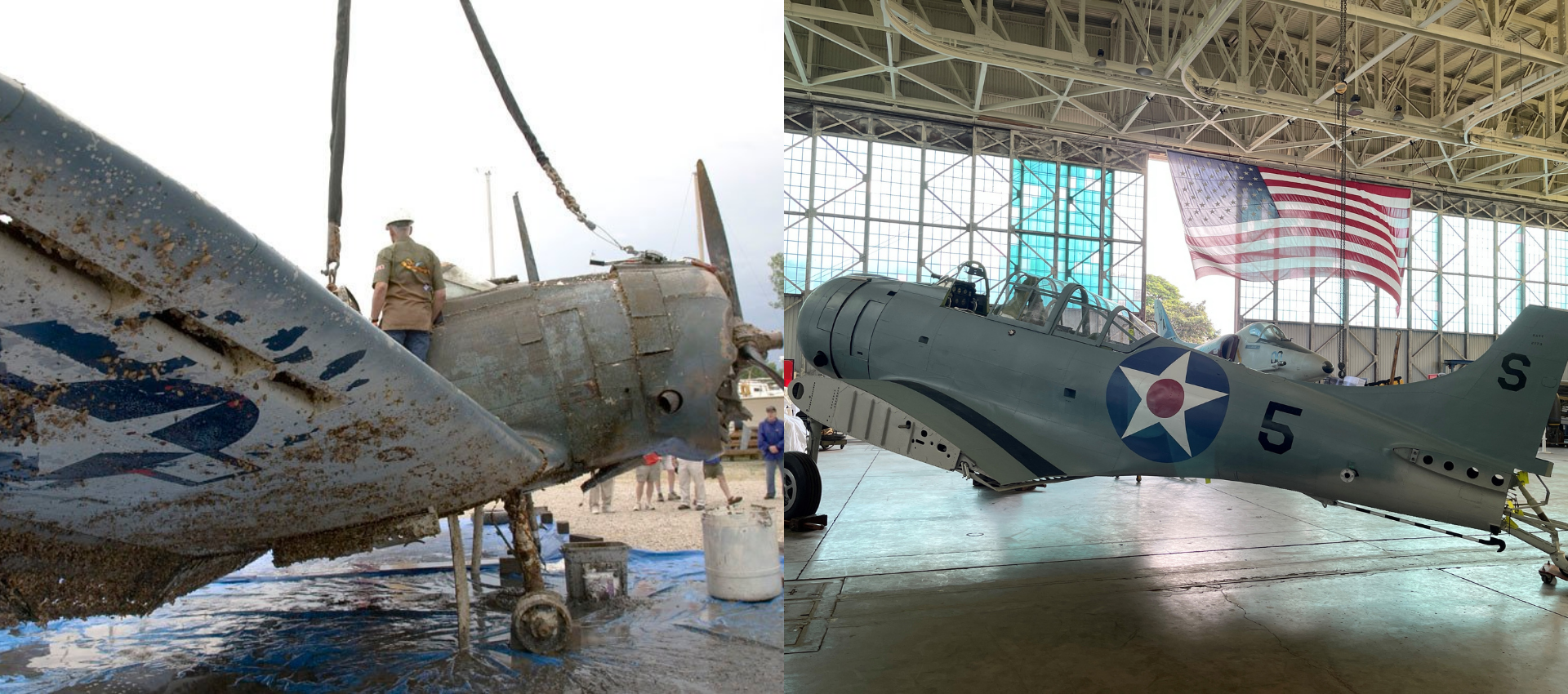Our Douglas Dauntless SBD-2P
December 10, 2021Plucked From Lake Michigan, Displayed at Pearl Harbor
Did you know the Douglas Dauntless SBD-5 currently on display in Hangar 37 is on loan from the National Naval Aviation Museum (NNAM)? It was pulled from Lake Michigan on December 4, 1995, after decades of sitting in a cold, watery grave. Nearly 14 years later, on June 19, 2009, another very special Dauntless, an SBD-2P, was also recovered from Lake Michigan and later designated to Pearl Harbor Aviation Museum.
Standing Nose Down in lake michigan

Of the 5,936 storied Scout/Dive Bombers built between 1940 and 1944, only a fraction survived the intervening 81 years. Even fewer were preserved in a “time machine-like” condition. The prized addition of a Douglas Dauntless SBD-2P to Pearl Harbor Aviation Museum’s collection would have been far less likely were it not for a carburetor icing incident over Southern Lake Michigan on February 18, 1944. Our SBD-2P stood nose-down for nearly 65 years in the cold depths of Lake Michigan.
The recovery effort at Lake Michigan was funded by former McDonald’s Chairman Fred Turner, as part of a tribute to his friend RADM James “Jig Dog” Ramage. Because it was going to take a fair bit of time to restore Pearl Harbor Aviation Museum’s SBD-2P Bureau Number 2173, NNAM loaned us its SBD-5 Bureau Number 36711, which is currently on display in our Battle of Midway exhibit. The Museum’s SBD-2P, a Pacific WWII veteran, was sent to our friends at the Air Zoo Aerospace & Science Museum in Kalamazoo, Michigan, where they have been working to restore the aircraft to its former glory.
The design of the SBD evolved through six iterations during the war, adding self-sealing fuel tanks, armor, and increasing the number of machine guns. Along with the design changes, sub-categories designate the versatile aircraft’s warfare applications.
For instance, the P in our SBD-2P designation indicates the original configuration the Navy ordered from the Douglas Aircraft plant for this aircraft to support photo-reconnaissance. Of the 87 SBD-2s built, only 14 were configured for photoreconnaissance.
The largest number of Dauntless dive bombers manufactured was the SBD-5. Numbering 2,965 units, the SBD-5 had a 1,200 hp engine and increased ammunition capacity.
Serving Aboard the USS Enterprise

All records of Navy aircraft are ordered and individually identified by assigned Bureau Numbers. The records of our Douglas Dauntless SBD-2P, Bureau Number 2173, trace the aircraft from delivery to the Navy in early 1941 as a photoreconnaissance aircraft, to its assignment to Scouting Squadron (VS)6 on the aircraft carrier USS Enterprise.
The aircraft was subsequently assigned to a Battle Force pool at San Diego in August 1941. It was still in California on December 7, 1941, and assigned to a Battle Force pool at Pearl Harbor one month later. At this point, our SBD-2P Bureau Number 2173 (BN2173) appears to have been confused with the recordkeeping for SBD-3 Bureau Number 2179 (BN2179).
Crashing while assigned to the uss hornet

The SBD-3 crashed in an incident while assigned to the USS Hornet. Handwritten notations on the aircraft’s history cards recorded 2173 instead of 2179. This created a conundrum for aviation historians.
Researching other official Navy records, historians and researchers identified the Bureau Number error and proceeded to unravel the fascinating history of our SBD-2P. The search for our SBD’s history reads like any great detective investigation. Dates, momentous historical events, heroic exploits, and the stories of the brave crews of BN2173 emerge as an engaging narrative tracing the aircraft from San Diego to Pearl Harbor, to loading it as cargo on the USS Yorktown, to its front-line VS-5 squadron assignment during the Battle of the Coral Sea, to its training support at three mainland Naval Air Stations, to its service as part of the Lake Michigan Carrier Qualification Training Unit, and finally its crash during training exercises for landing practice on carriers-underway.
The pilot, Lt. John Lendo, survived this final incident, and although it spent more than half a century under the cold waters of Lake Michigan, it was not to be the final resting place for BN2173.
As the team in Kalamazoo nears the final stages of restoration, we are preparing to welcome our SBD-2P home to Pearl Harbor. Thanks to donor support, funds were raised in 2020 to execute step one of the exchange – shipment of the SBD-2P from Kalamazoo to Hawaii.
With support from the Collings Foundation, our currently displayed SBD-5 will be shipped to Massachusetts, where it will be on display at the Collings Foundation Museum. Once our historic SBD-2P is on display in Hangar 37, it will provide authentic context to the challenge faced by naval aviation during the aftermath of the December 7, 1941 attack on Pearl Harbor.
“Our SBD will provide context to the challenge faced by Naval Aviation during the aftermath of the December 7, 1941 attack on Pearl Harbor.”
Arrival at Pearl Harbor Aviation Museum


Join us at Pearl Harbor Aviation Museum to visit this stunning example of a legendary Dauntless dive bomber and the telling of BN2173’s intriguing story.






